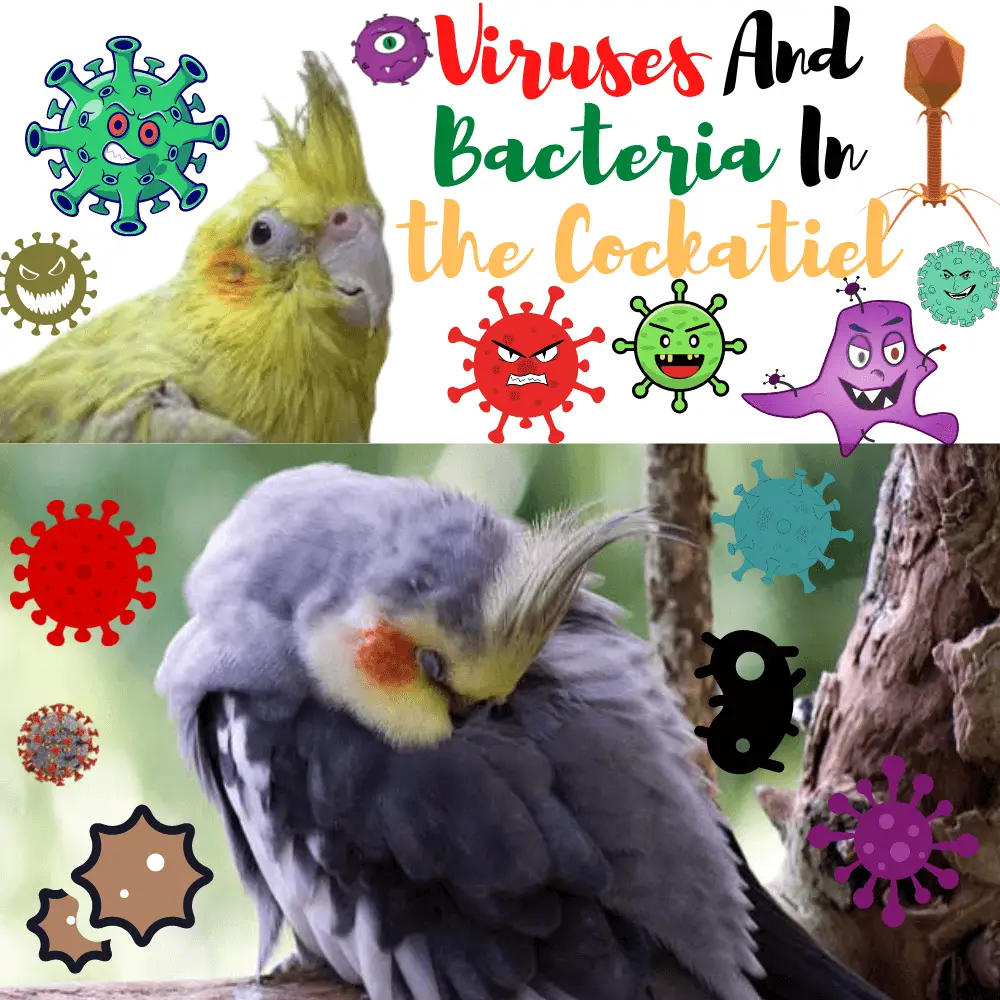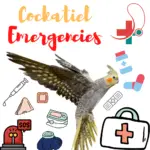
Viruses and bacteria in the cockatiel: Cockatiel diseaseWild and domestic birds, including poultry, can become infected with Chlamydia psittaci. Birds that can get the infection include parrots, cockatiels
, parakeets, macaws, canaries, pigeons, chickens, ducks, and turkeys. In caged birds, the time between exposure to Chlamydia psittaci and the onset of the disease varies, ranging from three days to a few weeks. Infected birds have the following symptoms:
- drowsiness
- tremors
- weight loss,
- respiratory discomfort,
- diarrhea.
In birds, the infection can be latent. Thus, an infected bird may appear healthy and have no symptoms for a while. Birds infected with Chlamydia psittaci can shed this bacterium intermittently or sometimes continuously for weeks or even months.
In birds with latent infection, the stress associated with nutritional deficiencies, crowding, breeding, laying eggs, and long transports can lead to the excretion of the infectious agent. The bacteria is excreted in the droppings or nasal secretions of infected birds, and infected birds can transmit the disease for several months.
What is psittacosis?
In humans, psittacosis is an infectious disease with flu-like symptoms (similar to those of influenza) that are mild and specific. The term psittacosis refers to any infection or disease caused by Chlamydia psittaci, one of the microorganisms of the genus Chlamydia. This disease can be transmitted to humans by infected birds. Psittacosis is also called parrot disease, ornithosis, or chlamydia.
Beak and feather disease, or PBFD in cockatiel
PBFD (Psittacine Beak and Feather Disease) is caused by a circovirus affecting about fifty species of psittacines. This virus damages the keratin of the bird: thus, an affected bird will have symptoms in its plumage, legs, and beak.
PBFD can thus be suspected when the animal has bilateral alopecia, discolored, brittle, shiny, or rarefied feathers, deformed (in the first place the tectrices and down), or presenting hemorrhages at the base.
This pathology is contagious and some birds can sometimes be healthy carriers (and therefore easily contaminate others) by inhalation and ingestion of volatile feather powder or soiled food. Vertical transmission is also possible: eggs from affected parents will give chicks carrying the disease. An analysis carried out on the feathers reveals the presence of circovirus.
The disease is associated with bacterial, fungal, and viral superinfections and has an immunosuppressive action. Unfortunately, there is no treatment at the moment, so quarantine of all birds is necessary.
cockatiel polyomavirus
The polyomavirus is transmitted from parents to offspring during regurgitation. Only unweaned young, with an immature immune systems, are susceptible to the disease. Adults, on the other hand, are healthy carriers.
The symptoms, which may not all be present, are lethargy, lack of appetite, distended abdomen, soiled and dirty cloaca, weight loss, delayed growth, and death…
In the case of AEM birds, the polyomavirus can be transmitted through feeding instruments or even the farmer’s clothes or hands (via feather dust).
There is no treatment, so strict quarantine of the farm is necessary.
Psittacosis of the cockatiel
The exact name of psittacosis is chlamylophilosis (sometimes also called Chlamydia), it is caused by a gram-negative bacterium Chlamydophila psittaci.
It is a zoonosis that is therefore transmissible to humans and extremely contagious. Contagion occurs through the secretions of the bird (stool, urine, saliva, or nasal secretions). Birds can go several months without developing symptoms of the disease, so they are asymptomatic carriers. Until the day when a weakening such as stress, illness or even a deficiency allows chlamylophilosis to develop.
Several types of symptoms exist: respiratory (bronchopneumonies, sinusitis …), digestive (diarrhea, regurgitation …), or even ophthalmological (conjunctivitis …). The bird no longer feeds and withers in an average of 2-3 weeks. Serological screening is possible. However, even cured the animal will remain excretory of the germ throughout its existence and can therefore remain contagious: euthanasia of animals tested positive is often prescribed by veterinarians
Cockatiel salmonellosis
Salmonellosis is a disease with mainly digestive symptoms and zoonosis. The animal is affected by acute diarrhea, rapid weight loss, and sometimes regurgitation. The animal eats little, and if it seems to be looking for food it does not ingest it. He trembles remains prostrate in a corner and have fever peaks.
Organs such as the spleen or brain can be damaged, which leads to a worsening of the general condition and almost systematic condemnation of the bird. A disease of bacterial origin, the bacterium can be found in contaminated water or food, but also via carrier animals.
Proventricule disease, or PDD in cockatiel
Proventricule disease, or PDD, is a disease of viral origin that appears to be caused by avian-bornavirus. It causes inflammation of the nerve tissues of the animal’s body, to the point of causing paralysis of the muscles. Among the first affected, the nerves of the proventricle are often the first to be affected, which gave its name to this disease. Highly contagious, this pathology requires rigorous isolation of sick animals.
Among the symptoms, we note particular effects at the digestive and nervous levels. The animal can no longer digest properly: its crop is full and its abdomen distended, its stool is smelly and sometimes has partially digested seeds, its belly can be soiled. It is thinning and may have difficulty feeding or even no longer feeding at all. Nervous symptoms are defined by paralysis of the muscles of the wings and paws leading to difficulty flying and even standing. It can be a victim of tremors or loss of balance.
An X-ray will confirm a distended proventriculus. The disease is incurable and fatal
Cockatiel staphylococcus
Staphylococcus aureus is a naturally occurring bacterium, but an injury in the cockatiel can sometimes have disastrous effects. In these rare cases, the bacteria penetrate deep into the wound to multiply and cause necrosis as well as hemorrhagic lesions. The infection can then cause crusty vesicles (kinds of blisters) located particularly on the wings, abdomen, and breech.
Tuberculosis in cockatiels
Agents of avian tuberculosis are highly resistant mycobacteria that can survive for several months in the environment and several years in the soil. This is a zoonosis. Psittacines are considered resistant to tuberculosis but can be affected by its avian form, Mycobacterium avium, and even in rare cases by the human form: M. tuberculosis.
Following a long incubation of 3 to 4 weeks, the pathology is declared by skin disorders, including crusts localized in the head.
Various pathologies of cockatiel
Fatty liver disease of the cockatiel
Also called “fatty liver disease”, this pathology is linked in the vast majority of cases to a poor diet (but intoxication is also possible). The bird whose diet is too fat will gradually see the cells of its liver filled with fat. The process will be faster if the animal is confined to its aviary for too long without the possibility of getting enough physical exercise. Eventually, such pathology can lead to risks of liver failure or hepatic lipidosis.
In cockatiels, fatty liver disease can be easy to observe for most mutations: feathers that are normally white take on a yellowish tint, mainly on the subtle bands. If you notice that the white of your pet turns yellow, but also that it quickly runs out of breath during physical exertion, then it is time to analyze its diet more closely and take it out of its aviary more often! Start by removing peanuts and black sunflower from his diet.
A blood test performed by the veterinarian is also possible to diagnose this effect.
Heat stroke in cockatiel
Wings ajar, hyperventilation (rapid breathing, open beak)? If it’s very hot, your cockatiel may be hyperthermic. Above all, it is important not to wet your budgies when it is very hot. Make sure they always have a corner in the shade and cool water at will. Avoid stressful situations or heavy strains that would cause your body temperature to rise.
Symptoms of a Sick cockatiel and What to Do Before Going to Your Avian Vet
SOURCE:Love of Pets




















